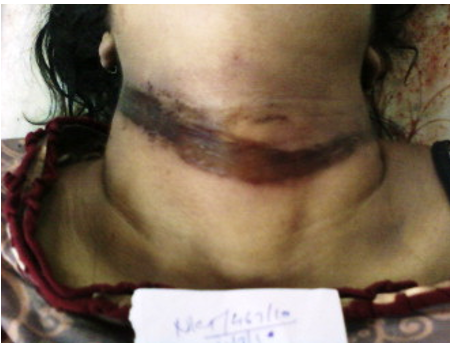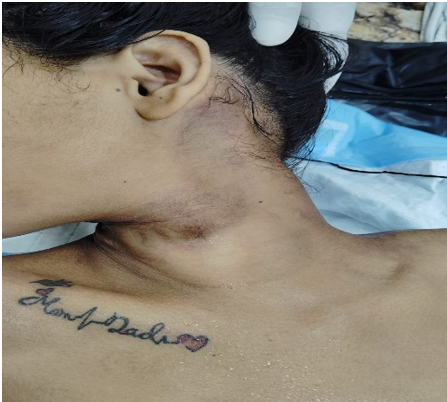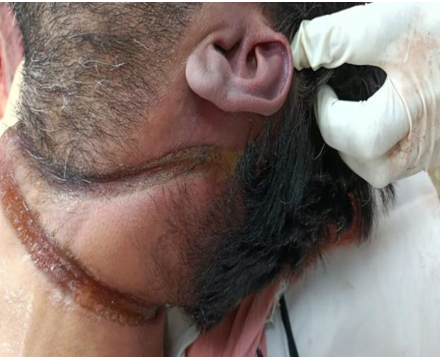Introduction
While hanging is a popular method of suicide, there are many debates about whether it is actually homicidal or Suicidal. In these kinds of situations, ligature marks impression becomes more significant. A pressure furrow, known as a ligature mark or patterned abrasion, on the neck is the most important and distinct indicator of hanging death.1 The mark initially seems pale and anaemic, but as the post mortem time lengthens, it takes on a brown, parchment-like consistency. 2 Depending on the type of ligature, if broad, soft, and yielding material was used for a short period of time, the mark may be discontinuous or even non-existent; if the material is rigid and the suspension is protracted, the mark will be more defined.3, 4
In decomposing and putrefied bodies, the presence of tight jewellery, collars, etc. around the neck creates a pattern that resembles a ligature mark.5, 6 On the other hand, Casper JL concluded that a ligature placed on the neck within two hours of death could have caused the noose marks shown on the neck during hanging. Therefore, noose marks on the neck do not always indicate that a person was conscious when they were hanged. A forensic pathologist must therefore be able to distinguish between real suicidal hanging and fake hanging.
There are visible accompanying injuries such as bruises, nail marks, and rope burns near the ligature mark. Rope contact against the skin causes rope burns. Due to the high heat produced by this friction, blisters are more prone to form.7 Serum-filled blisters, nail marks on neck and abrasions with haemorrhages (Periligature injuries) at the ligature mark clearly imply that suspension occurred during life.
Two consistent indicators of antemortem hanging are periligature injuries and dried salivary stains flowing from the mouth's angle. Nevertheless, this crucial indicator of antemortem hanging is lost when family members or medical professionals remove the salivary stains in an effort to revive the patient. In light of the fact that periligature injuries and ligature material are crucial indicators of antemortem hanging, the present study was done to underscore the significance of these findings.
Materials and Methods
The present prospective study was conducted from January 2024 to July 2024. Out of the 1276 autopsy performed throughout the study period, 231 cases of deaths attributed to hanging were examined. The information about the victims, including their age, sex, method of death, kind of ligature material, and presumed cause of death, was gathered from police and inquest records; family histories, crime scene photos, and crime scene investigation reports. In a few cases, the crime scene was also studied. Wherever available, a close inspection of the ligature mark was conducted. Virchow Technique was used to dissect the bodies. Layer by layer, the internal findings of the neck's dissection were described.
Results
From January 2024 to July 2024 a total of 1276 autopsy were conducted; of these, 231 cases (18.10%) involved hanging and were thoroughly examined for this investigation. Table 1 shows that the age range of 21 to 30 years old accounts for the majority of hanging deaths in both male and female victims. Out of the 231 cases, in 219 cases or 95.68% of the total, complete hanging was found, whereas just 12 cases involved partial hanging. Inside the house, all of the females and the majority of the males (89.47%) hanged themselves. Six men committed suicide by hanging in their place of employment, six at the hospital due to chronic illnesses, and four on the agricultural farm (Table 2).
Table 1
Distribution of cases according toage and sex
Table 2
Distribution of cases according to place of Hanging
The ligation mark was obliquely positioned (93.10%), incomplete (85.52%), and above the level of thyroid cartilage (87.06%) in the majority of instances [Table 3]. On the other hand, Table 3 shows that in certain cases it was horizontal (6.89%), below the level of thyroid cartilage (1.72%), and complete (14.48%). In 211 cases, the type of ligature material used to conduct hanging suicide was identified, whereas in 20 cases, it was not possible to identify the type of ligature material.
akes it clear that chunni (29.52%) was the most often utilised ligature material, closely followed by nylon rope (27.61%). Men most frequently hanged themselves with nylon rope (33.33%), closely followed by coir (27.53%), while women most frequently used chunni (55.55%). Additionally, we received a case where a patient hanged himself due to a chronic disease, using hospital bandages as ligature material.
Table 3
Distribution of cases according to particulars of ligature mark
Table 4
Distribution of cases according to ligature materials used
Table 5
Findings on external examination other than ligature mark
|
External Findings |
N |
% |
|
Marks of dribbling of saliva |
26 |
11.20 |
|
Bleeding from mouth and nostrils |
12 |
5.17 |
|
Facial congestion |
06 |
2.58 |
|
Discharge of urine and faeces |
10 |
4.31 |
|
Seminal purging |
30 |
12.93 |
Twenty-six cases showed saliva dribbling from the angle of mouth whereas twelve cases showed bleeding from the mouth and nostrils (Table 5). In 24 cases, periligature injuries were discovered as and abrasions with haemorrhages in 18 cases and blisters in 6 cases [Figure 1, Figure 2, Figure 3]. Of these twenty four cases, eighteen of them employed hard ligature material, such as nylon or coir, and only six of them used soft ligature material, such as chunni. It implies that the use of firm ligature material increases the risk of periligature injuries (Table 6). Despite a thorough dissection of the neck, we were unable to detect any damage to the hyoid bone, thyroid cartilage, or sternocleidomastoid muscle.
Discussion
From January 2024 to July 2024, a total of 1276 autopsy were conducted; of these, 231 cases (5.74%) involved hanging. The percentage of hanging-related deaths reported by Ambade et al. (4.1%), Patel et al. (4.65%), Rao (3.31%), and Spinelli et al. (3.29%)7 is marginally lower than that of the current study.
Ages 21–30 account for 39.65% of the cases, followed by age 31–40 (21.55%). Similar to this study, studies by Ambadeet al., Patel et al., Chinchole et al.8 indicated that the age range of 21 to 30 years old was the most common for hanging suicide. Rao,6 on the other hand, noted that the majority of people who hanged themselves were between the ages of 31 and 40. In line with the current study, Ambade et al.4 and Zachariah T et al.5 reported that male preponderance peaked in 21–30 years, whereas Rao6 reported that it peaked in 31–40 years. Since the study was conducted in a large metropolis, the majority of the victims were from the surrounding area.
We found that partial hanging (4.31%) was less common than complete hanging (95.68%). The results of Ambade et al., Zachariah T et al.,5 and Rao 6 who reported 67.7%, 98.75%, and 88% of complete hanging instances, respectively, are in line with this finding. Nevertheless, Kohler et al. 9 reported partial suspensions in the majority (83.41%) of the hanging cases, which runs counter to the findings of the current investigation.
The most common location for males to hang out in the current survey was their house, followed by their place of employment (3.94%), a hospital (3.94%), and a farm (2.63%). Every girl killed herself by hanging in her own home. Therefore, the most popular location for victims to hang themselves to death was their house. This is most likely caused by the secluded location and the simplicity of finding various ligature materials for ligation at home. In a comparable manner, Hossain et al. 10 Barman & Bairagi. 11 and Vijayakumari 12 reported that, respectively, 63.8%,97%,83.31%, and 92.3% of victims killed themselves at home, making it the most common location for suicide.
In the majority of instances, it was found that the ligature mark was obliquely situated (93.10%), incomplete (85.34%), and above the level of thyroid cartilage (87.06%). The results of this investigation are in line with those of Rao D, 6 who found that the ligature mark was often partial (80.68%), oblique (87.88%), and above the level of thyroid cartilage (82.58%).
Chunni was the most often utilised ligature material in the current study (29.52%), closely followed by nylon rope (27.61%). Males most frequently hanged themselves with nylon rope (33.33%), followed by coir (27.53%), while women most frequently used chunni (55.55%). According to Ambade et al.13 chunni (10.2%) was the second most often used ligature material, after nylon rope (63%). They reported that chunni (45%) was the most frequently utilised ligation material by females, and nylon rope (67.3%) was the most frequently used ligature material by males. According to Tumram et al., 14 chunni (22.5%) and nylon rope (32.5%) were the two most often utilised ligature materials.
In 11.2% of the cases, dried salivary stains were seen, which are indicative of antemortem hanging. It was noted in 11.8% and 29.73% of the cases, respectively, by Ambade et al.4 and Spinelli et al.7 The body may have been examined after being held in cold storage for the night, or relatives or medical professionals may have attempted to remove the stains in an effort to revive the patient, which could account for the low reporting of this crucial antemortem hanging indicator.
Periligature injuries are another crucial symptom of antemortem hanging. Nooses that tighten the neck might occasionally squeeze the skin and create vertical folds that abrasively brush against the noose. Friction from the tight noose may cause serum-filled blisters.15 Abrasions with bleeding are highly suggestive of antemortem hanging, however ecchymoses by itself does not indicate whether hanging occurred during life or not.1 In 10.34% of the instances (n = 12), Periligature injuries were observed. In 75% of the cases, they took the form of abrasions with bleeding, and in 25% of the cases, blisters. According to Bardale RV et al.14 periligature injuries were seen in 17.5% of instances; blisters made up 28.5% of these, ecchymoses, 50%, and abrasions, 57.1%.
According to a correlation study, periligature injuries were more common (n=9) when hard ligature materials like nylon rope and coir were used, and less common (n=9) when soft ligature materials like chunni were used. The results of this investigation are in line with those of Tumram et al. , who noted that abrasion is the most frequent type of periligature injury and that these injuries are more common when abrasive, durable ligature material is utilised.
Conclusion
The authors were greatly assisted in confirming the cause of death in cases of suspected hanging by a meticulous investigation of the ligature material, the ligature mark over the neck, and the interior structures of the neck in conjunction with circumstantial evidence. The authors were further helped by periligature injuries caused by firm ligature material in establishing the antemortem nature of hanging and ruling out foul play.




